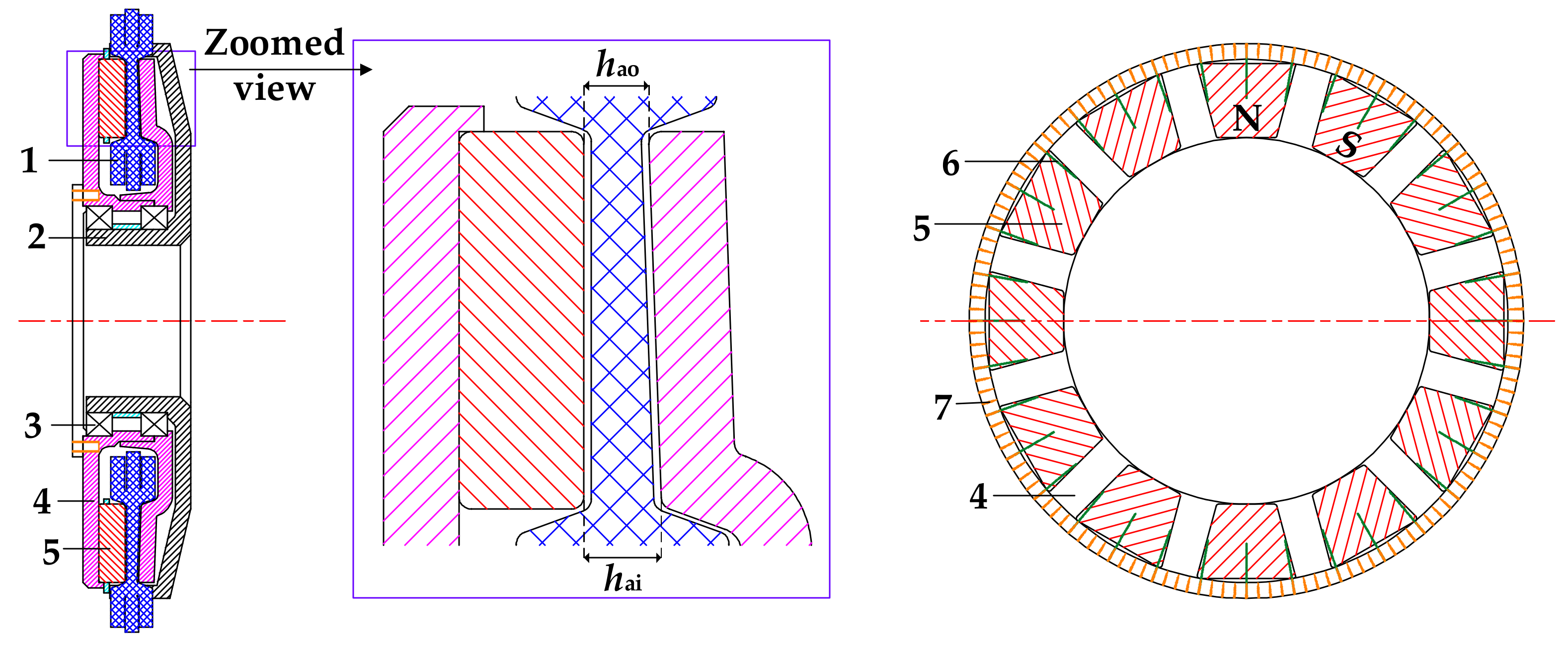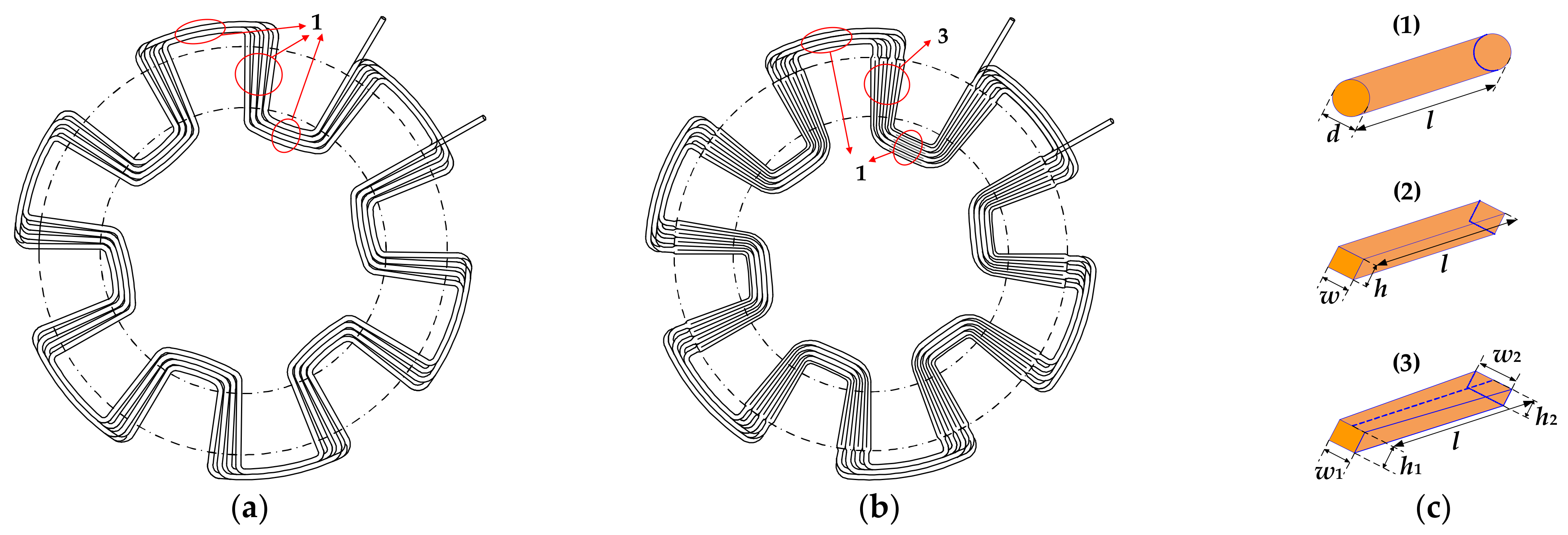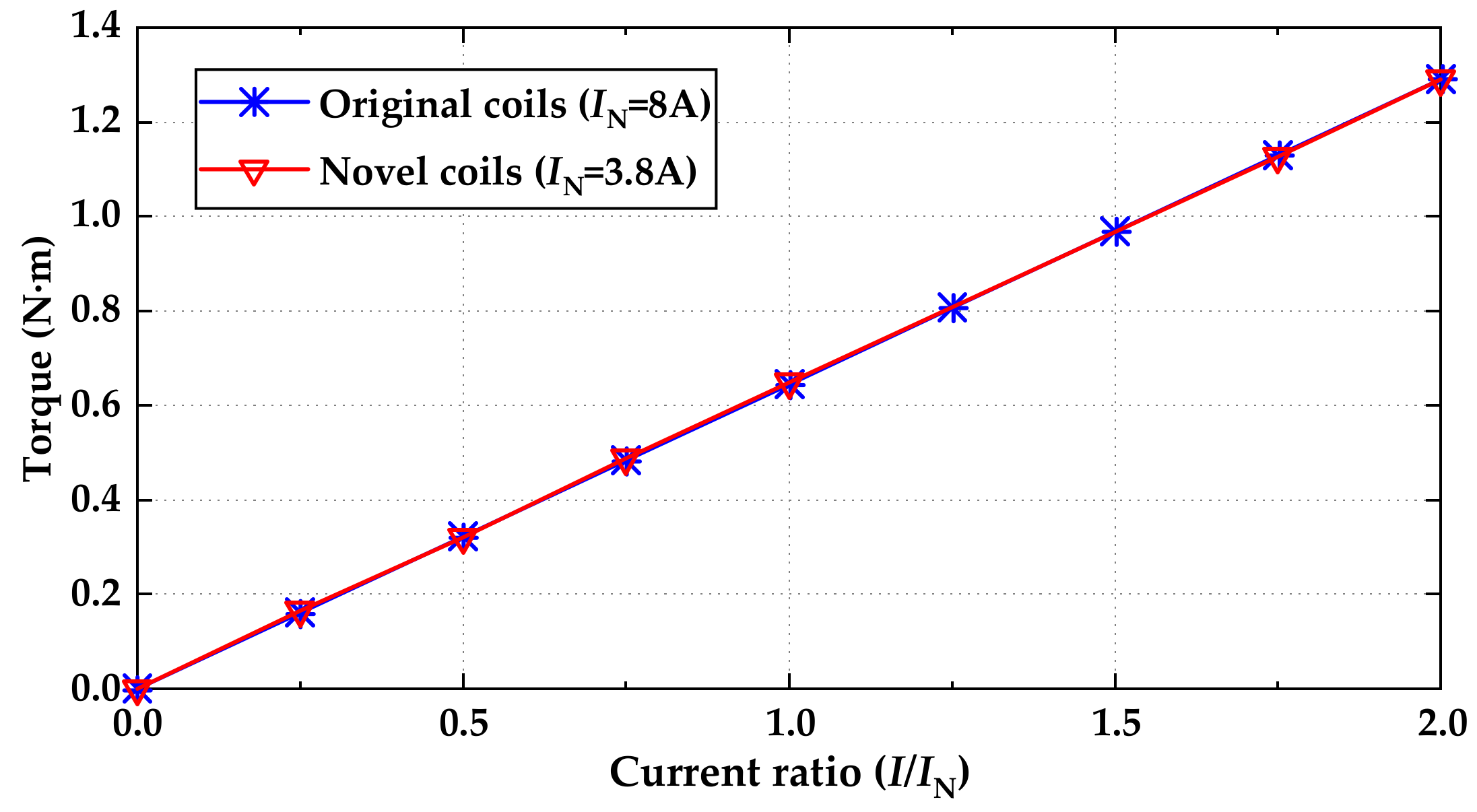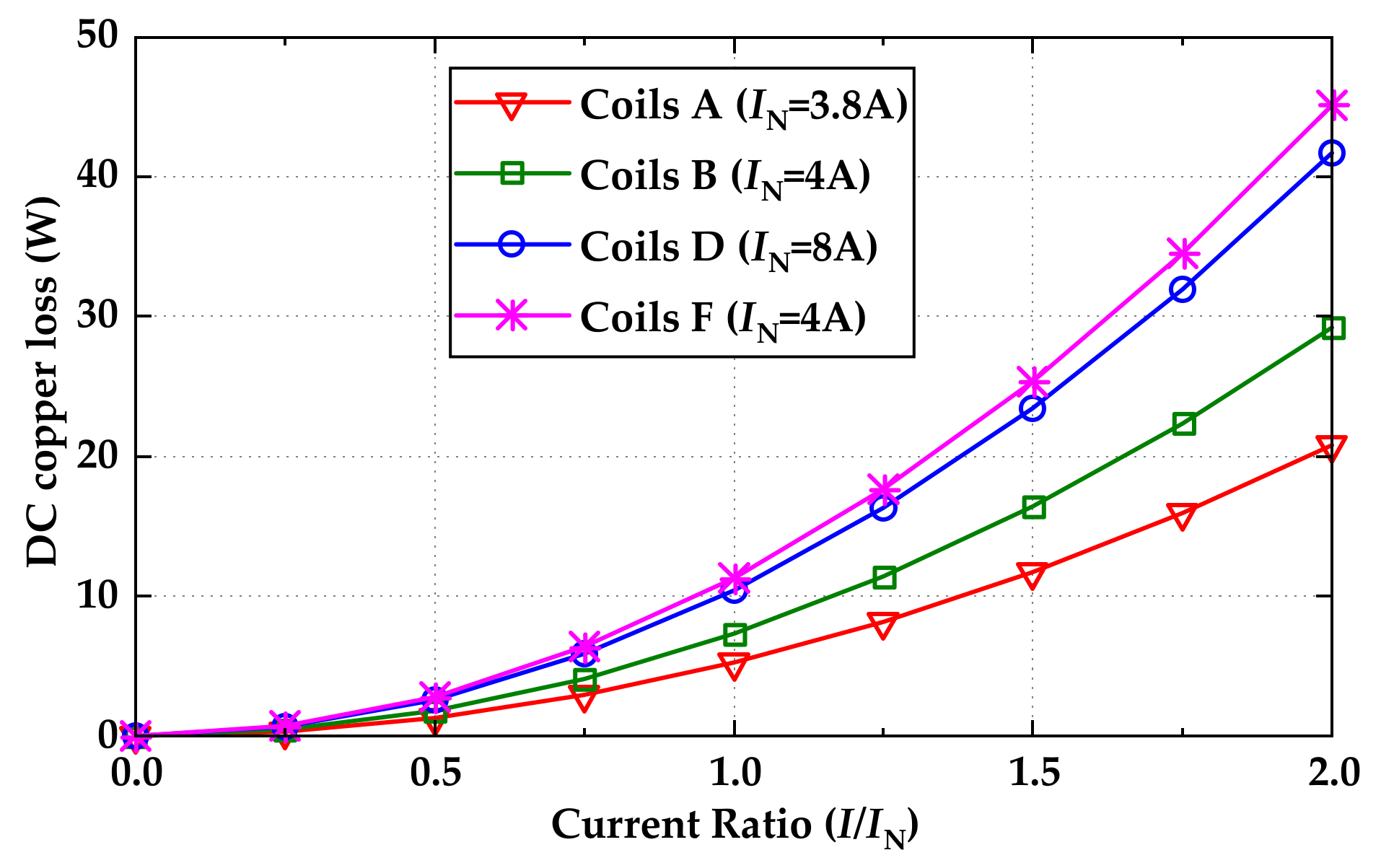Design and Analysis of Coreless Axial Flux Permanent Magnet Machine with Novel Composite Structure Coils
Abstract
:1. Introduction
2. Structure and Parameters
2.1. AFPM Machine with Coreless Stator
2.2. Novel Composite Structure Coils
2.3. Filling Factor
3. Electromagnetic Analysis
3.1. FEA Model
3.2. Air Gap Flux Density
3.3. No-Load Characteristics
3.4. Load Characteristics
4. Winding Loss and Efficiency
4.1. DC Copper Loss
4.2. Eddy Current Loss
4.3. Efficiency
5. Conclusions
Author Contributions
Funding
Institutional Review Board Statement
Informed Consent Statement
Data Availability Statement
Conflicts of Interest
References
- Wang, C.; Han, J.; Zhang, Z.; Hua, Y.; Gao, H. Design and optimization analysis of coreless stator axial-flux permanent magnet in-wheel motor for unmanned ground vehicle. IEEE Trans. Transp. Electrif. 2021, 8, 1053–1062. [Google Scholar] [CrossRef]
- Shariati, O.; Behnamfar, A.; Potter, B. An integrated elitist approach to the design of axial flux permanent magnet synchronous wind generators (AFPMWG). Energies 2022, 15, 3262. [Google Scholar] [CrossRef]
- Lee, J.-Y.; Lee, J.-H.; Nguyen, T.K. Axial-flux permanent-magnet generator design for hybrid electric propulsion drone applications. Energies 2021, 14, 8509. [Google Scholar] [CrossRef]
- Wang, R.J.; Kamper, M.J.; Van der Westhuizen, K.; Gieras, J.F. Optimal design of a coreless stator axial flux permanent-magnet generator. IEEE Trans. Magn. 2005, 41, 55–64. [Google Scholar] [CrossRef]
- Frank, Z.; Laksar, J. Analytical design of coreless axial-flux permanent magnet machine with planar coils. IEEE Trans. Energy Convers. 2021, 36, 2348–2357. [Google Scholar] [CrossRef]
- Taqavi, O.; Taghavi, N. Development of a mixed solution of maxwell’s equations and magnetic equivalent circuit for double-sided axial-flux permanent magnet machines. IEEE Trans. Magn. 2021, 57, 8104411. [Google Scholar] [CrossRef]
- Wang, W.; Zhou, S.; Mi, H.; Wen, Y.; Liu, H.; Zhang, G.; Guo, J. Sensitivity analysis and optimal design of a stator coreless axial flux permanent magnet synchronous generator. Sustainability 2019, 11, 1414. [Google Scholar] [CrossRef] [Green Version]
- Tokgöz, F.; Çakal, G.; Keysan, O. Design and implementation of an optimized printed circuit board axial-flux permanent magnet machine. In Proceedings of the 2020 International Conference on Electrical Machines (ICEM), Gothenburg, Sweden, 23–26 August 2020. [Google Scholar]
- Geng, W.; Zhang, Z. Analysis and implementation of new ironless stator axial-flux permanent magnet machine with concentrated nonoverlapping windings. IEEE Trans. Energy Convers. 2018, 33, 1274–1284. [Google Scholar] [CrossRef]
- Fei, W.; Luk, P.C.K.; Jinupun, K. Design and analysis of high-speed coreless axial flux permanent magnet generator with circular magnets and coils. IET Electr. Power Appl. 2010, 4, 739–747. [Google Scholar] [CrossRef] [Green Version]
- Wang, X.Y.; Du, J.J. Performance analysis of a wedgy airgap disk coreless permanent magnet synchronous motor. In Proceedings of the 2006 IEEE International Conference on Mechatronics and Automation (ICMA), Luoyang, China, 25–28 June 2006. [Google Scholar]
- Huang, C.; Kou, B.; Zhao, X.; Niu, X.; Zhang, L. Multi-objective optimization design of a stator coreless multidisc axial flux permanent magnet motor. Energies 2022, 15, 4810. [Google Scholar] [CrossRef]
- Wang, X.Y.; Li, X.; Li, C.P.; Xu, S.J.; Ling, L.T. Design of a PCB stator coreless axial flux permanent magnet synchronous motor based on a novel topology Halbach array. Front. Inf. Technol. Electron. Eng. 2019, 20, 414–424. [Google Scholar] [CrossRef]
- Taran, N.; Rallabandi, V.; Ionel, D.M.; Heins, G.; Patterson, D. A comparative study of methods for calculating AC winding losses in permanent magnet machines. In Proceedings of the 2019 IEEE International Electric Machines and Drives Conference (IEMDC), San Diego, CA, USA, 12–15 May 2019. [Google Scholar]
- Tsai, M.C.; Hsu, L.Y. Design of a miniature axial-flux spindle motor with rhomboidal PCB winding. IEEE Trans. Magn. 2006, 42, 3488–3490. [Google Scholar] [CrossRef]
- Wang, X.Y.; Pang, W.; Gao, P.; Zhao, X.X. Electromagnetic design and analysis of axial flux permanent magnet generator with unequal-width PCB winding. IEEE Access 2019, 7, 164696–164707. [Google Scholar] [CrossRef]
- Shin, D.-Y.; Jung, M.-J.; Lee, K.-B.; Lee, K.-D.; Kim, W.-H. A study on the improvement of torque density of an axial slot-less flux permanent magnet synchronous motor for collaborative robot. Energies 2022, 15, 3464. [Google Scholar] [CrossRef]
- Wang, X.Y.; Lu, H.D.; Li, X. Winding design and analysis for a disc-type permanent-magnet synchronous motor with a PCB stator. Energies 2018, 11, 3383. [Google Scholar] [CrossRef] [Green Version]
- Andriollo, M.; Tortella, A. Preliminary design of an axial flux machine with coreless stator for flywheel applications. In Proceedings of the 2018 XIII International Conference on Electrical Machines (ICEM), Alexandroupoli, Greece, 3–6 September 2018. [Google Scholar]
- Kesgin, M.G.; Han, P.; Taran, N.; Lawhorn, D.; Lewis, D.; Ionel, D.M. Design optimization of coreless axial-flux PM machines with Litz wire and PCB stator windings. In Proceedings of the 2020 IEEE Energy Conversion Congress and Exposition (ECCE), Detroit, MI, USA, 11–15 October 2020. [Google Scholar]
- Tang, R.Y. Morden Permanent Magnet Machines Theory and Design; China Machine Press: Beijing, China, 1997; pp. 315–317. [Google Scholar]














| Parameter | Value |
|---|---|
| Rated output power | 200 W |
| Rated speed | 3000 r/min |
| Torque | 0.64 N·m |
| Number of poles | 12 |
| Outer diameter of rotor | 100 mm |
| Inner diameter of rotor | 70 mm |
| Physical length of air gap | 0.3 mm |
| Radial length of PMs | 14.2 mm |
| Axial length of PMs | 5 mm |
| Axial length of rotor core | 3 mm |
| Type | Structure | Wire Parameters (mm) | hs (mm) | N | Ns | ζi | ζo |
|---|---|---|---|---|---|---|---|
| A | Wedge | 0.76 × 1.25 (w1 × h1); 1.05 × 1 (w2 × h2) | 2.5 (hsi); 2 (hso) | 288 | 1 | 0.995 | 0.963 |
| B | Rectangle | 0.76 × 1.25 (w × h) | 2.5 | 288 | 1 | 0.995 | 0.697 |
| C | Round | 1.3 | 2.6 | 288 | 1 | 1.337 | 0.936 |
| D | Round | 1.3 | 2.6 | 144 | 1 | 0.669 | 0.468 |
| E | Round | 1.25 | 2.5 | 288 | 1 | 1.286 | 0.9 |
| F | Round | 0.625 | 2.5 | 288 | 2 | 0.643 | 0.45 |
| Parameter | Original Stator | Final Optimized Design |
|---|---|---|
| Total number of turns | 144 | 288 |
| Axial length of stator | 2.6 mm | 2.5 mm (inner)/2 mm (outer) |
| Distance between double rotors | 3.2 mm | 3.1 mm (inner)/2.6 mm (outer) |
| Structure of effective conductors | round | wedge-shaped |
| Parameters of effective conductor | 1.3 mm | 0.76 mm × 1.25 mm (w1 × h1)/1.05 mm × 1 mm (w2 × h2) |
| Structure of ends | round | round |
| Parameters of ends | 1.3 mm | 1.3 mm |
| Rated current | 8 A | 3.8 A |
Publisher’s Note: MDPI stays neutral with regard to jurisdictional claims in published maps and institutional affiliations. |
© 2022 by the authors. Licensee MDPI, Basel, Switzerland. This article is an open access article distributed under the terms and conditions of the Creative Commons Attribution (CC BY) license (https://creativecommons.org/licenses/by/4.0/).
Share and Cite
Wang, X.; Li, T.; Cui, X.; Zhao, X. Design and Analysis of Coreless Axial Flux Permanent Magnet Machine with Novel Composite Structure Coils. Energies 2022, 15, 5162. https://doi.org/10.3390/en15145162
Wang X, Li T, Cui X, Zhao X. Design and Analysis of Coreless Axial Flux Permanent Magnet Machine with Novel Composite Structure Coils. Energies. 2022; 15(14):5162. https://doi.org/10.3390/en15145162
Chicago/Turabian StyleWang, Xiaoyuan, Tianyuan Li, Xiaohong Cui, and Xiaoxiao Zhao. 2022. "Design and Analysis of Coreless Axial Flux Permanent Magnet Machine with Novel Composite Structure Coils" Energies 15, no. 14: 5162. https://doi.org/10.3390/en15145162






